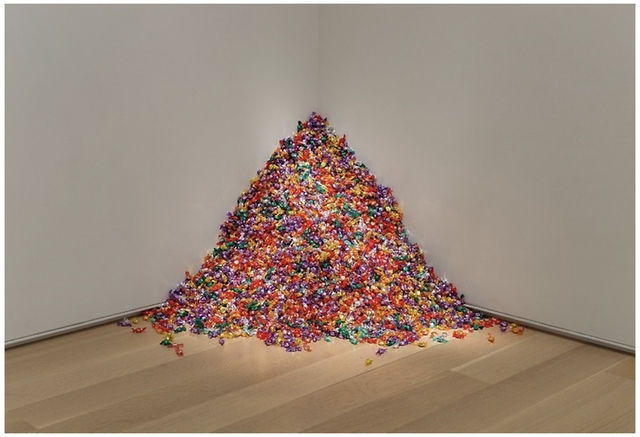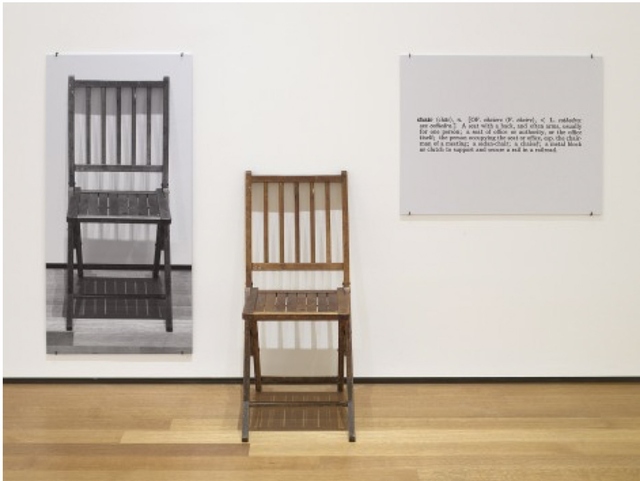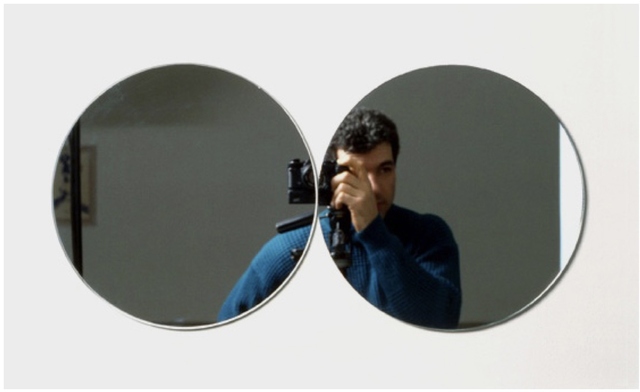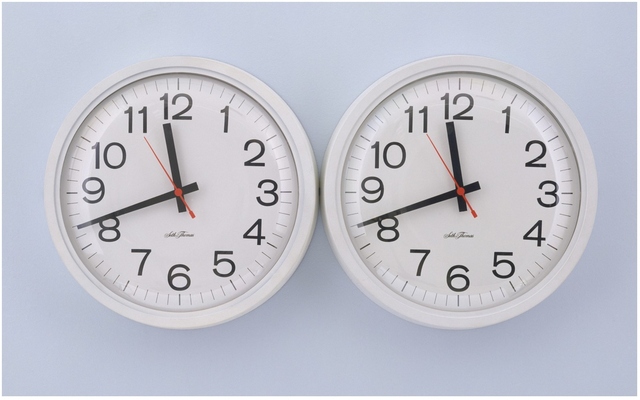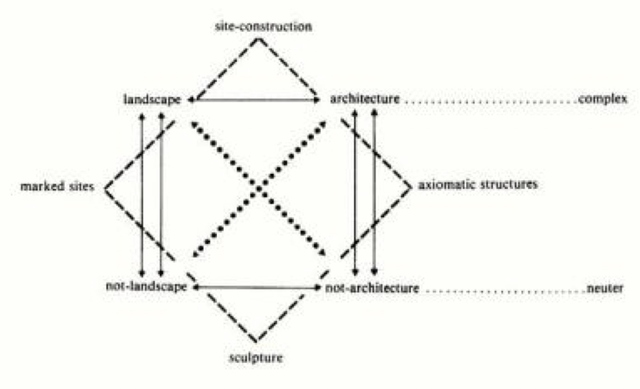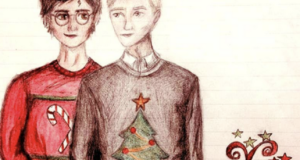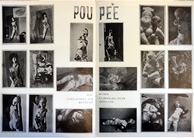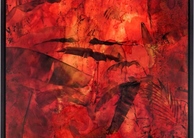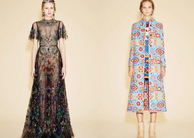Félix González-Torres's Portrait of Ross: Beyond Form and Content
By
2020, Vol. 12 No. 11 | pg. 1/1
IN THIS ARTICLE
KEYWORDS
AbstractFélix González-Torres’s Untitled (Portrait of Ross in L.A.) [1991] uses its unconventional medium and presentation to reveal holes in the limited language of the traditional art historical narrative. Composed of a pile of metallic-wrapped candy, the work of art ideally weighs 175 pounds, but its mass depletes as visitors are invited to take pieces from the pile. Exhibitors of the candy pile replenish the candies when deemed necessary. The artwork serves as a portrait of the artist’s passed lover, Ross Laycock, who died from AIDS-related complications. The installation creates an accessible narrative that parallels Ross’s body’s deterioration from AIDS with the candy pile’s slow depletion. However, binary descriptions of form and content limit insight on the work of art’s performative dimension. Research on Georges Bataille’s early twentieth-century theory of the formless reveals parallels between the philosopher’s interest with the base and invisible elements as valuable parts of the whole work. Repetitive and mundane candies bring the work of art closer to everyday life while allusions to devouring the dying body of Ross reveal its morbidity. Portrait of Ross’s unorthodox characteristics focus on deconstructing equivocal form in art-making rather than creating concrete definitions. In the midst of politically and socially-charged works of art clamoring for attention on the AIDS crisis, artworks made from ordinary objects by Félix González-Torres (1957–1996) could be easily dismissed by those who are not looking. A series of candy spills in which a pile of candy arranged in either corners of a gallery or flat on the ground are often characterized as consistent and uniform installations. In these works, González-Torres offered the opportunity to take away a piece of candy from the pile to consume, keep, lose, or discard, giving the works a physical dimension in which visitors can have choice in how they experience the work of art. Visitors expend resources and energy on a quotidian act which could have been practiced at the cashier countertop of a restaurant or in the comfort of home. Piles of candy formed by the artist turn a banal object into a work of art managed by backstage staff who are constantly replenishing the candy. Their banality speaks to the works’ quiet nature that calls attention to vaster subjects outside the context of AIDS, and candies become a memento of cruelty, love, loss, and the human condition. However, these didactic works of art elicit characteristics unaddressed by the traditional Postmodern narrative. Unlike a static painting or sculpture, the candy series retain agency by commanding labor from museum workers and visitors. Interpretations of these works of art have been limited by the binary descriptions of form and content, but the interactive aspect complicates traditional boundaries that limit insight into the performative nature of González-Torres’s artwork. Because of the numerous relationships created between his installation and its participants, beginning with the curator and ending in the mouth of the visitor until replenished by a museum worker again, the candy spills present more than a sacrament-like offering; they also create a subjective and experiential feature. Viewing these installations as multi-part works of art gives a new dimension to González-Torres’s candy pieces as experiences in time and space and offers a new dynamic approach to his seemingly object-based artworks. Participants affect and alter these take-away pieces, and thereby become parts of the whole work, interjecting into González-Torres’s authorship. The candy spills are no longer just tangible installations characterized by the personal experiences of the artist but are instead a communal ritual subject to change in interpretation.González-Torres’s portrait of his late lover, Ross Laycock, Untitled (Portrait of Ross in L.A.), 1991 [fig. 1], exemplifies provocations to the traditional Postmodern narrative. The portrait is composed of a mountain of brandless, metallic-wrapped, multi-colored candies. Wall text invites visitors to take pieces from the pile. The tangible candies represent the body of Ross who passed from AIDS-related complications, and the act of taking and diminishing parallels how the disease depleted his body. The mass of candy is prescribed to be 175 pounds, which is equivalent to Ross’s weight when he was healthy. The pile of candy and its weight are not permanent, though, and the exhibitor constantly replenishes it to match the ideal dimensions. Museum visitors participate in the diminution of Ross’s surrogate which the artist subjected to this everlasting cycle. Arguably one of González-Torres’s most famed works in the artist’s candy series, this specific portrait carries feelings of a morbid and perverse yet poignant atmosphere that is juxtaposed by the shiny candy. A pile of candy has invited strangers in public spaces into the private life of González-Torres and serves as a rupture in the heteronormative art historical canon, giving it notoriety. Bataille's FormlessIn the laborious and grotesque relationships formed between of Portrait of Ross and its participants, it is useful to consider how it produces a post-modernist incarnation of the “formless.” When French philosopher Georges Bataille first coined the term informe, or formless, in 1929, it was to unravel and look beyond the façade of metaphorical and meaningful concepts of art.1 Evaluating art’s most debased elements, formless unearths the unspeakable, repulsive, and invisible things that cannot be formed into thoughts or words but must be felt instead. The unranked qualities of art that provide feeling and disgust are often dismissed for discussion on concrete or aesthetic merits. The formless focuses on creative and destructive impulse rather than meaning and definition. Bataille appreciated art for its process and what it did to the viewer rather than academic or philosophical value, which has no other goal but to “[give] a frock coat to what is.”2 Scholars contemporary to Bataille consistently dressed art to give things meaning, value, aesthetic intrigue, or form, and the frock coat became symbolic of the bourgeois and institutionalized ideals of art objects and art-making that Bataille refuted and denounced.3 Stripped of its metallic cellophane wrappers and poetic recollections of a past lover’s life, Portrait of Ross in its most naked element remains everyday, store-bought candy and is only made meaningful through its multiplication in an institution.4 Removed from context, the candies are just a collection of objects rather than art. The art narrative that Bataille denounced allows the candy pile’s most grotesque elements to hide under an abstract portrait that appears poetic and deeply personal. A pile of candy constructs the front and seduces visitors with colorful metallic wrappers to indulge in eating sweets off the floor, while the participant naively devours the body of the artist’s dead lover. The aesthetic aspects, weight, and state of the candy pile simply act as its “frock coat” of the moment while it constantly changes. It is the action of taking pieces of candy away and replenishing them that de-forms or un-forms the object. This creative and destructive process is neither visible nor tangible but felt as a death-drive or an impulse to destroy knowing the exhibitor will nurture it back to its original state. Formlessness extracts Portrait of Ross out of its elevated status and brings it to its most raw and earthly intentions. Bataille seeks to undermine the worship of art as something beyond the earthly realm.5 Formless brings things to the value of “spider or spit,” dissipating the limits that separate the cherished and the obscene, or art and everything else.6 In Portrait of Ross, the boundaries between art and observer cross, and the art-object no longer exists solely in an exhibition space, but it also lives in the pocket or mouth of the participant. The action of taking also revokes authority from the artist as the sole author defining unequivocal form and meaning.7 Portrait of Ross immerses observers of the object into an experience that contributes to the shape and value of the artwork. The once hierarchal roles of creator and consumer are therefore egalitarian. In its continuously morphing sizes, colors, and weights, the pile of candy ultimately lacks definite shape and uniform representations, and its complacency to outside forces and the environment humbles the nature of this artwork. Dependency on space thus complicates the commoditization and fetishizing of the art object. Completely nomadic, the pieces of candy determine the enshrined space. Shifted by the activities of visitors and museum workers, the work has an indefinite form, weight, and candy-count. Interpretation of the pile becomes open-ended as González-Torres called for an “endless supply” of candies but does not suggest when replenishment is necessary.8 The ownership of the work is dependent on a document that gives specifications for the installation, which Gonzalez-Torres never intended to be displayed with or beside the work of art.9 Because ownership of the work only constitutes a certificate of authenticity rather than the pre-made art object, the work of art loses its traditional attributes of value.10 Institutions that house González-Torres’s candy spills do not store the candy in masses, which is susceptible to its environment and must be monitored to ensure it is safe to consume. In the case of Portrait of Ross, it remains intangible when in storage and only performs when it is on display. The work taunts the art market formed by capitalist regimes and institutionalized beliefs of value, or Bataille’s similar idea of “bourgeois prisons.”11 Constructed beliefs of significance and worth limit where the utility of a work belongs, and Portrait of Ross undermines those limitations by exaggerating the intangible and mundane. Unseen labor creates the project, and the candies continue to expend resources for replenishment and upkeep. The work requires the exhibitor to rebuild it every time it goes on display therefore it no longer possesses the same degree of authorship and desirable exclusivity. Given that the art object is reformed every time it goes on view, the ideal manifestation of the portrait is therefore never consistent. Although the ideal weight remains 175 pounds, there is not a definitive moment when the pile is reduced so much that it ceases to be the same work of art. These inconsistencies in the art-object deny a uniform and single definition of this work of art. Bois's and Krauss's Updated FormlessWhile the core of Bataille’s formless offers a broad manner to examine Portrait of Ross, evaluating a pile of candy solely under an early twentieth century philosopher is incongruent to González-Torres’s context. Therefore, a contemporary reconsideration of the term “formless” offers a timelier canon to compare the work of art. Reconsidered by Rosalind Krauss and Yves-Alain Bois in the field of twentieth century and primarily post-war art, formlessness continues to exhibit itself in postmodernist efforts to debase art. In the context of the contemporary scholars, formless serves as an operational tool that rejects Modernism’s lineage of mastery.12 They use the term to “perform” slippages in modern works that suggest, for example, “Jackson Pollock’s Full Fathom Five (1947) can be read as a fried egg.”13 These readings of famed works of art bring them down to the earthy realm so that movements like Abstract Expressionism are no longer framed as an untouchable masculine genius. The post-Bataille formless also grapples with new mediums of art creation. No longer limited by the binary genres of painting and sculpture, Bois’s and Krauss’s examples are comparable to Portrait of Ross. While González-Torres’s oeuvre borrowed aesthetic strategies from styles of the time, Portrait of Ross eagerly dismantles institutionalized and conventional ideals of art creation and presentation.14 He effectively takes attributes from parts of the postmodern canon, appropriates, and then “queers” them.15 Its bare and abstract form defined by weight alludes to Minimalist tendencies, but it evades the “objecthood” and “theatricality” Michael Fried actively criticized in his essay “Art and Objecthood.”16 While intimate relationships exist between observer and art, its anthropomorphic presence is not hidden and openly present in the title and active interaction.17 Its readymade appearance may suggest its place in the post-conceptual canon, and like Joseph Kosuth’s One and Three Chairs (1965) [fig. 2], it exists in three prongs: its title, the candies, and the instructions that define the ideal weight which parallels Kosuth’s photograph, object, and definition respectively. But, because the candies do not recall Ross’s name nor a body and vice versa, the individual prongs are arbitrary to each other.18 The lack of hierarchy in object and idea alienates the work of art from norms of Conceptual art. Minor deviations from the canon prompt consideration of the candy spill with the formless and the “outsiders” of the mainstream art narrative. Portrait of Ross diverges from the academic and idealized discourse of art that Bataille tried to disturb, and it is a sequel to Bois’s and Krauss’s continuation of formlessness in Postmodern art. Using the scholars’ own dissection of Bataille’s theories, Portrait of Ross can be primarily analyzed under two of their narrowed vectors of formlessness: horizontality and base materialism. These two qualities reveal how the work defies form and debases itself as an object familiar to spectators’ everyday lives. The installation is subject to primarily three external acts and forces that relate to the proposed elements of formlessness: taking, eating, and gravity. When extracted from the installation, these three forces lack symbolic quality. The disparate and unorganized confluence of changes to the work uncovers the lack of uniformity and purity of González-Torres’s form and content. Although it serves an autobiographical purpose, the artwork suggests fluidity by allowing participants to bring their own history and context into the experience.19 By asking viewers to participate and influence the work of art through the three tasks, he allows the experiences of other people to penetrate the unfixed message of this work.20 The prefix “Untitled” further distances it from a designated meaning or definition.21 Bataille called for a dictionary to tell what words do rather than what they mean, so to understand how form and pure definition in a work of art dissolves, formless must see past the poetic and bring the work down to its most mundane tasks.22 Bataille’s diction parallels González-Torres’s discussion of the dictionary as a work of “literature” that serves to define words only in the context of the time it was written.23 As definitions change, their tasks are vulnerable as well. 24 Because of the installation’s fluidity in both shape and meaning, the pile of candy depends on relationships with visitors and the space and time in which the installation exists. Because Portrait of Ross lacks uniformity each day of its presentation, the unseen force of gravity manages the current shape and state of the pile of candy. Bois and Krauss label this dimension of formlessness as “horizontality,” and it lives in the laborious and dirty aspects of the work of art. Portrait of Ross exists on a gallery floor where the candies intermingle with dirt tracked in by visitors and other garbage of public spaces. Gravity’s pull on debris and candies contribute to the baseness of the whole work, but the force is also resisted by certain elements of candy pile. Because Portrait of Ross exists on the ground of a public space, it alludes to the same gravitational characteristics as Jackson Pollock’s drip paintings. Pollock exhibited horizontality not only by removing easel painting’s elevated status but also by antagonizing forces of gravity.25 Painted on the ground, Pollock’s drip paintings gathered the debris of his cigarette and surroundings which would become embedded in the final artwork. When a Pollock drip painting hangs perpendicular to the gallery floor, the paint and debris that dried horizontally defies gravity because it is unable to drip in the vertical direction again.26 Portrait of Ross also operates on multiple planes in order the convey gravity’s effect on the metaphorical dead body. Exhibitors create it on a horizontal plane and pour it onto the ground as Pollock poured paint onto the canvas. A live person bending down to pick up a piece interferes with the effects of gravity. The candy is limp and inactive, much like a lifeless Ross, and requires participants to pick fragments of the body up. Visitors must also be aware of their own relationship with gravity as they bend down to pick something off the ground. Opposition to the force makes participants aware of the unseen and feel something that is taken for granted. Paintings within a gallery hung by invisible wire or precarious sculptures that implement balance and precision seem to defy gravity, while Portrait of Ross forces its spectators and participants to be at the mercy of the intangible element of the work. Horizontality and gravity work together to reveal the candy pile’s use of labor to a grotesque and base end. Gravity also subjects change to the pile of candy, since nothing binds the work into a permanent shape. The work transcends form because it is constantly active and morphing. Its transient configuration depends on how the candy is poured that day. It reacts to how the past participant touched the pile and how the displaced candy disrupted the others, allowing gravity to roll them down the mound. The physical or visual aspect, therefore, is at the discretion of gravity and not the hand of the exhibitor nor González-Torres. Portrait of Ross’s malleability pits the work against conforming to a single manifestation of a defined shape or form and makes possible a most literal reading of formlessness. Robert Morris’s discourse on the “anti-form” reveals that non-rigid materials are susceptible to augmentations of prior form, or Gestalt.27 He experimented with mediums subject to change when exposed to gravity, concluding that gravity-dependent works are anti-form.28 Gravity is active and felt as a force in the “random piling, loose stacking, and hanging” of medium-specific works.29 While anti-form suggests a previous or ideal form of the material, Portrait of Ross, from its conception, never had an original state. Gravity always forced inconsistency onto the art object. Acknowledging that gravity is a factor in the experience of the installation, Portrait of Ross can be read as actively changing and actively formless. The shape and weight change until, in the eyes of the assembler, it passes as a work of art. When visitors are invited to pick up a piece of candy, there is a self-awareness of gravity as they bend down to retrieve candy from the ground. As pieces are removed, gravity shifts the candies and forms a pile determined by the laws of physics. Intersecting acts and forces open the work to chance rather than a prescribed-end. Gravity links all of these activities together, complicating the end result of the ritual. Portrait of Ross’s conditions are subject to the effects of time as gravity alters the appearance and reception of the work of art. By asking for participation, the work evokes ritualistic archetypes present in many doctrines. The ceremonial nature of offering candy as a surrogate to a body parallels the Christian rite of offering the Eucharist host.30 This sacrament-like custom not only evokes the familiarity of communion but also contradicts the strict Christian framework that grants the symbolic value of the wafer.31 While González-Torres’s portrait calls for an endless replenishment of Ross’s substitute body with easily accessible and purchasable candies to eat, the body of Christ is not constantly reproduced at the will of supply and demand. This act commoditizes the holy body and mimics Christ’s martyrdom with Ross’s. As the body of Christ is offered as a wafer, Portrait of Ross serves as a final gift of sustenance from the artwork that in turn depletes the candy pile and Ross’s body. Its space becomes a site to mourn and celebrate his life and tragedy. This potentially blasphemous act must be seen through the context of the AIDS epidemic, when the intersection of religion and politics very much interfered with the livelihoods of González-Torres and his partner. The work extracts the sacred act of receiving or eating the Eucharist to reveal it as a base and mundane function of the human body. To Bataille, sanctity existed in the “wholly other” and suggested that something sacred was just a foreign body. 32 On two extremes, Bataille’s idea gave no difference to holy matter or excrement. Under formlessness, the “sacred” is interchangeable between its religious and its foreign connotation, and it serves as a catch-all term that covers the holy, dirty, and grotesque, thus lending itself to “base materialism.” Encompassing the lowest and utmost degrading matter on Earth, base materialism is the most tangible aspect of Krauss’s and Bois’s scrutiny of formlessness. 33 Because, as Bois points out, “God is only sacred on the same basis as shit,” Portrait of Ross not only finds itself in the space between these two definitions of the sacred, but it also narrows the margin between a religious and vulgar experience.34 A play on life and death, the work uses the livelihood of sharing, tradition, and the intimate act of consumption to contrast the passing of Ross.35 While the ritual is executed an infinite number of times, the participant forgets his or her relationship with the work once the sweet candy is placed in the mouth. The artist engages the participant in a ritual that undermines religious practice and offers temporary sweetness for the viewer to indulge in, which then in turn reminds them of their own mortality. After his partner’s death, González-Torres’s work became constant mementos of love, loss, and time. Often existing in pairs, the ordinary objects he used in his creations served as surrogates for Ross and himself, but his art tell timeless archetypes of partnership that transcends time and space. Consider, for example, “Untitled” (March 5th) #1 (1991) [fig. 3]. The inclusion of Ross’s birthday in the title recalls his presence in the two round mirrors hanging side by side. Visitors see their image in one reflection and must grapple with the absence of their image in the other. This unpeopled reflection emphasizes the Ross’s absence, so viewers are forced to face the presence of (or lack of) both González-Torres and his partner as well as their own image flattened into the same plane with other spectators.36 Another set of couple objects, Untitled (Perfect Lovers) [fig. 4] consists of two round clocks initially set to the same time, but as time passes, they become out of sync and their batteries die—usually one before the other. The quiet ticking of the clocks in present time simulate and perhaps synchronize with the viewers own heartbeat.37 These couplings confront viewer with tragedy and remind them of their own mortality. Portrait of Ross lacks a partner as an art object. Instead, the participating museum visitor acts as a placeholder for its partner and must watch and feel the weight of the artwork’s diminution. The temporal relationship between object and visitor becomes an intimate parallel that mimics González-Torres’s and Ross’s bond. The allusion to past and present all within a singular space makes the work truly formless. The Expanded FieldUnder the context of Bois and Krauss, Portrait of Ross is neither avant-garde nor completely removed from the lineage of the art historical canon. It is not the first of post-war American artists that created untraditional three-dimensional art. Unorthodox in its medium and open invitation to touch, the pile of candy contradicts conventional ideals of sculpture and installations. Krauss extended other fields of scholarship in order to create a space in art history for “formless” works of art that do not fit neatly into conventional classifications of medium and work types. In the text “Sculpture in the Expanded Field,” she organized post-war American Art into a Klein 4-group to account for potentially formless works that previously stretched and broadened the field of sculpture until it was no longer elastic enough to do all modern three-dimensional art justice (fig. 5).38 Because Portrait of Ross does not match the usual archetype, the work fits better as a “marked site” under Krauss’s theory. Using the expanded field as a guide, Portrait of Ross’s categorization is determined by its qualities that make it both a “landscape” and “not a landscape.” Physically on the ground and without a barrier to protect it, the pile of candy takes on the quality of a landform. A hill-like form, the work of art’s landscape can be read horizontally much like a landscape or a mound on the earth. The candy lays on the ground rather than a pedestal or pallet and acts like an unbroken continuation of the floor that rises up. At the same, its mobility and medium makes it not-landscape as well. The pile of candy is unnatural and did not exist before the space was marked. The creation of the mound and the candy itself is artificial to where it resides. Though, a broader use of the term “natural,” a gallery’s corner may be experienced like landscape in that it represents the normative space in which art exists and the viewer finds it natural to see art existing on walls beside white empty corners.39 Krauss suggests Robert Smithson’s Spiral Jetty (1970) [fig. 6] exemplifies the liminal space between “landscape” and “non-landscape.”40 Like Portrait of Ross, it is an unnatural alteration of a site that was once permanent and natural, but it exists in a space that was previously unmarked. Spiral Jetty and Portrait of Ross are works of art because of an artificial interference with the landscape previously there. It is the mark of the artist or, in the case of the candy pile, the museum worker that makes the site significant. Existing between these two opposites, Portrait of Ross depends on its location and the acts of others. As a marked site, the work of art serves as memoriam of Ross Laycock and keeps González-Torres’ lover alive in a public space where he can be visited. Portrait of Ross as a marked site thus places importance on the ever-changing space it occupies. Marked Site for Grotesque LaborA marker for a passed loved one, the space carries an elegiac and ceremonial connotation. The actions surrounding Portrait of Ross serve as ritualistic, even sacrificial and sacramental activity. González-Torres invites the viewer to participate in the deconstruction of his lover’s body. The gruesome act repeats infinitely until the candy is replenished when almost depleted, only to be repeated again. Ross’s surrogate both suffers and is kept alive due to the candy’s infinite life cycle. The work is indeed personal and autobiographical to González-Torres, but, because it exists in and is intended for public gallery spaces, the site becomes a place for social interaction. Although the acts of participants as well as the actively changing construction of the candy pile privileges spectatorship, observance, and a performance, Portrait of Ross offers a shared experience that removes the hierarchal roles of performers and audience. As visitors are encouraged to take candies and consume them, the acts are more communal rather than performance art. Performance suggests that there is a differentiation between the audience and the performers, but, in the case of Portrait of Ross, the two roles are played by the same people.41 The cast and the participants therefore have an indistinguishable or perhaps non-existent hierarchy, allowing this occasion to be communal and serve as a social forum. The community of participants is united not only by their interchangeable and shared status as audience and performer but also by the intimate act of eating. Encouraging banal and commonplace activities brings the marked site close to everyday life and closer to a social forum rather than a performance.42 There is a collective familiarity to the ritual aspect of picking up a piece of candy, unwrapping it, and sharing it in a space surrounded by people, or in the case of some, being confronted with the evidence of people augmenting the candy pile. The act of taking and replenishing becomes a collaborative effort that constantly shifts the condition of the marked site. Producing a community of consumers, Portrait of Ross is shaped, quite literally, by its participants. Without a set cast, the experience depends on the people who participate, thus destabilizing a concrete and uniform definition of its form and content. Because the public is invited to alter the work of art, the pile is subject to the imagination of the beholder. The acts of taking candy to consume solicit grotesque and perhaps sexual diction that ascribes obscene qualities of formlessness to it. The candies have a seductive nature and lure visitors with their shiny wrappers and promise of sweet indulgence. There is also a lustful and enticing part about touching a work of art which is usually prohibited in a museum setting. The candy form itself is vulnerable and submissive to the acts of visitors unwrapping it and diminishing it.43 Formlessness does not exhibit itself in any explicit claims to sexuality, but the implicit connotations and imagination of the viewer fill in for the erotic undertones.44 These implications are at the whim and imagination of the beholder. The pile of candy covertly alludes to a sexual nature by act of seduction, temptation, and then sucking. González-Torres himself said, “I’m giving you this sugary thing, you put it in your mouth and you suck on someone else’s body. And in this way, my work becomes part of so many other people’s bodies.”45 If the visitor chooses to refrain from touching or eating the candy and chooses to watch how others have deconstructed the work, they take on a voyeuristic approach in participation. By abstracting the body of Ross, the pile of candy leaves these sexual implications to the imagination of the participant. The participants are left to contemplate their own feelings or possibly even shame as they leave immaturely sucking on a piece of candy. There is a great deal of laborious effort to fully conceive and execute Portrait of Ross. The work exploits the labor of not only the participant but also the exhibitor. The process begins with physical effort to pour and mold a 175 pound pile of candy into its ideal dimensions. Because the work is made tangible through directions on a certificate rather than a permanent object or installation, it recruits the labor of others to form the marked site even after the artist’s passing. When on view, the candy pile continues to solicit the work of others for it to manifest its purpose. Participants bend down to retrieve candies off the floor. Labor in this context means that workers bring their own personalities and therefore subjectivity to the process.46 Although a communal ritual highlights community and uniformity rather than individuality, laborers contextualize acts through their own experiences. Once the piece of candy is consumed, all the visitor has to show for his or her efforts is an empty candy wrapper that ends up in the trash. Portrait of Ross, a work of art, evolves into garbage by the end of a participant’s labor. Once again, this evolution brings the artwork to its most concrete state of formlessness: base materialism. Once a participant is done viewing or literally consuming the work, it loses all value as a piece of disposable and undesirable trash or even as excrement. The relationship between the pile of candy and the viewer who participated in consuming a piece of candy exists even after he or she has left the gallery space and forgotten about the work of art. It is not until the candy leaves the body that the ritual is over, and the relationship is terminated. Termination ends with excretion—the most base state of earthly being. But, in this context and the context of formlessness, filth and trash retain as much value as the candies in their uneaten phase. Bataille’s constant circling to waste and the foul led to his label as the “excremental philosopher.”47 In his essay “The Language of Flowers,” Bataille criticizes moralizing philosophical associations of flowers with purity or love.48 Instead, he emphasizes their “hairy sexual organs” and concludes the essay with an image of flower petals picked off and falling into manure.49 Much like the sweet shiny candy in its untarnished state, a flower’s fate ends in waste regardless of its previous symbolism. In this way, formlessness seeds itself into the core of Portrait of Ross and uses the labor of others to acquire a life of its own as an amorphous object. Ephemeral and unpredictable, Portrait of Ross is not easily quantified, and its intangibility further complicates materializing the marked site. In fact, Portrait of Ross emulates a readymade, which historically mocked the ideals of institutional art collecting. The work calls for pre-purchased and mass-produced candies to be revered as a work of art because it sits in the corner of a gallery in a renowned institution. The candy pile’s existence is at the whim of the judgement and decisions of its owner. Despite existing in an institution and “owned” by a museum, Portrait of Ross requires that the institution purchase the candies. There is a great deal of continuous labor that is required for the replenishment of the pile of candy. Labor therefore becomes a part of the entirety of the work and difficult to commoditize. The art object is fleeting and animated through the care and attention of museum workers and owners.50 Unseen by most visitors of his artwork, the maintenance of the candy spill becomes an intangible myth—a labor of love that remains hidden to most visitors but plays a vital role in the reading of his candy spill as a whole. Because González-Torres did not provide a tangible unitary object or collection of objects which he named the single and sole portrait of Ross, the owner of his artwork, who is charged with the purchase of mass-produced candies, becomes another kind of author, giving his work infinite variations of subjective form and content. ConclusionWhile Bois and Krauss offer solutions to categorize other avant-garde works with theories of the formless and the Expanded Field of Sculpture, Portrait of Ross lacks a concrete space to exist in the lineage of art history. Its complexity is much deeper than its critique on the social and political response to the AIDS epidemic or its revolt against institutionalized ideals of works of art. Understanding how the art-object is affected by its various physical elements and requisite actions reveals the work of art’s malleability. Although a communal ritual suggests an emphasis on community rather than individuality, each member of the social act still brings their own impressions that affect their reading and view of the work. Portrait of Ross’s notoriety lends itself to more than aesthetics or its tragic narrative, but it is interesting because of how it makes participants and spectators feel. Intrigue with the grotesque, violent, and invasive are, perhaps, not distractions from the mundane, but they are an embodiment of it. Conflated meaning and purpose distract spectators, but Portrait of Ross embodies reality and brings art experiences back down to everyday life. This work of art is infinitely varied. The work calls upon laborious and at times grotesque acts that reveal a rituality that is deeper than just picking up a piece of candy. It calls for more than a reading of its form and content, but, under the modern theory of formlessness, its unconventional qualities reveal the web of relationships existing between participants, the museum, space, context, and time. Despite González-Torres’s efforts to keep Ross’s memory alive through the labor of participants and viewers, AIDS took the life of both lover and artist, revealing perhaps the most morbid aspect of the work. But, Portrait of Ross’s formless qualities constantly change the context of this work of art to match the state of society and the human condition. ReferencesBataille, Georges. Visions of Excess: Selected Writings, 1927-1939. Translated by Allan Stoekl, Carl R. Lovitt, and Donald. M. Leselie Jr. Minneapolis: University of Minnesota Press, 1985. Bishop, Claire. “Viewers as Producers” in Participation edited by Claire Bishop. London: Whitechapel, 2010. Bois, Yves-Alain, Benjamin H. D. Buchloh, Hal Foster, and Rosalind Krauss. Art Since 1900: Modernism, Antimodernism, and Postmodernism. New York: Thames & Hudson, 2004. Bois, Yves-Alain, and Rosalind E. Krauss. Formless: a user’s guide. New York: Zone, 1997. Boulvain, Thibault. Dancing with Myself. Venezia: Marsilio, 2018. Filipovic, Elena, Danh Vo, Carol Bove, Andrea Rosen, and Tino Sehgal. Felix Gonzalez-Torres. Specific Objects without Specific Form Felix Gonzalez-Torres Foundation, New York. London: Koenig Books, 2016. Foster, Hal. The Return of the Real: the avant-garde at the end of the century. Cambridge: MIT Press, 1996. Fried, Michael. “Art and Objecthood.” In Minimal Art: A Critical Anthology edited by Gregory Battock. New York: E.P. Dutton & Co., Inc., 1968. Getsy, David J. Abstract Bodies: sixties sculpture in the expanded field of gender. New Haven: Yale University Press, 2015. Hirsh, Jennie. “Double Take, or Theorizing Reflection in Gonzalez-Torres” in Contemporary Art and Classical Myth edited by Jennie Hirsh and Isabelle Loring Wallace. New York: Routledge, 2016. Krauss, Rosalind E, “Sculpture in the Expanded Field.” October 8 (1979): 30-44. Morris, Robert, “Anti-form.” Artforum 6, no. 8, (1968): 33-34. Lazzarato, Maurizio, “Immaterial Labor” in Work edited by Friederike Sigler. London: Whitechapel Gallery, 2017. Spector, Nancy, and Felix Gonzalez-Torres. Felix Gonzalez-Torres. New York: Guggenheim Museum, 1995. Wagner, Frank. Felix Gonzalez-Torres. Berlin: Neue Gesellschaft für Bildende Kunst (NGBK), 2006. Lorenz, Renate. Queer Art: A Freak Theory. Bielefield: Transcript, 2012. Varnedoe, Kirk. “Minimalism and After.” MoMA 4, no. 1 (2001): 2-5. Endnotes1.) Georges Bataille, “Formless” in Visions of Excess: Selected Writings, 1927-1939, ed and trans. Allan Stoekl (Minneapolis: University of Minnesota Press, 1985), 31. 2.) Ibid. 3.) Ibid, 31. 4.) David J. Getsy, “They Lack the Look of History: Transformable personhood and naming in Flavin’s System” in Abstract Bodies: sixties sculpture in the expanded field of gender (New Haven: Yale University Press, 2015), 254. 5.) Bataille, “The ‘Old Mole’ and the Prefix Sur in the Words Surhomme [Superman] and Surrealist,” in Visions of Excess: Selected Writings, 1927-1939, 33. 6.) Bataille, “Formless,” 31. 7.) Elena Filipovic, Specific Objects without Specific Form, (London: Koenig Books, 2016), 9. 8.) Lorenz, 151. 9.) Filipovic, 18. 10.) Frank Wagner, “Preface,” in Felix Gonzalez-Torres (Berlin: Neue Gesellschaft für Bildende Kust, 2006), 23. 11.) Bataille, “The ‘Old Mole’ and the Prefix Sur in the Words Surhomme [Superman] and Surrealist,” 33. 12.) Yve-Alain Bois, “The Use Value of ‘Formless,’” in Formless: a user’s guide (New York: Zone, 1997) 13-40. 13.) Ibid, 21. 14.) Wagner, “Preface,” in Felix Gonzalez-Torres, 22. 15.) Yves Alain-Bois, Benjamin H. D. Buchloh, Hal Foster, and Rosalind Krauss, “A Queering of Art” in Art Since 1900: Modernism, Antimodernism, Postmodernism (New York: Thames & Hudson, 2004) 608. 16.) Michael Fried, “Art and Objecthood,” ArtForum 5, no. 10 (June, 1967): 12-23, reproduced in Minimal Art: A Critical Anthology, ed. Gregory Battcock (New York: E.P. Dutton & Co., 1968), 116-47. 17.) Fried’s essay attributed hidden anthropomorphism in a work of art to the “theatricality” of Literalist or Minimalist art. 18.) Lorenz, 137-138. 19.) Filipovic, 8. 20.) Ibid. 21.) Lorenz, 138. 22.) Bataille, “Formless,” 31. 23.) Filipovic, 8. 24.) Ibid. 25.) Bataille, “Formless,” 31. 26.) Krauss “Horizontality,” in Formless: A User’s Guide, 97-98. 27.) Krauss, “Horizontality,” 97-98. 28.) The experiment begins by acknowledging a piece of felt as material visually subject to the laws of gravity, unlike the conventional material of sculptural and pictorial arts such as clay, marble, canvas stretchers, etc. Upon cutting the felt, the form remains the same until lifted vertically to reveal holes of the cut felt that were not resistant to the force of gravity. 29.) Morris, Anti-form, Artforum 6, no. 8, (1968): 35. 30.) Wagner, “Form, Reference and Context: Felix Gonzalez-Torres’ Candies,” in Felix Gonzalez Torres, 129. 31.) Ibid. 32.) Bois, “Base Materialism” in Formless: a User’s Guide, 52. 33.) Bois, “Base Materialism,” 53. 34.) Ibid. 35.) Thibault Boulvain, “Live Until You Drop,” in Dancing with Myself (Venezia: Marsilio, 2018), 135. 36.) Jennie Hirsch, “Double Take, or Theorizing Reflection” in Contemporary Art and Myth (New York: Routledge), 143. 37.) Ibid. 38.) Rosalind Krauss, “Sculpture in the Expanded Field” October 8 (1979): 30-44. 39.) Portrait of Ross takes on an architectural quality in both its form that is emphasized by height as well as the intervention of people altering its form. I do not recognize the pile of candy as a “constructed site” in this case because the portrait is not built but rather poured onto the floor and constantly changing. Krauss, “Sculpture in the Expanded Field.” 40.) Krauss, “Sculpture in the Expanded Field,” 41. 41.) Claire Bishop makes a similar argument for social art in the 1960s in “Viewers as Producers,” in Participation (London: Whitechapel, 2010), 10. 42.) Ibid, 10. 43.) Getsy, 254. 44.) Bois and Krauss “Part Object” in Formless: A User’s Guide, 154. 45.) Felix Gonzalez-Torres, qtd. in Nancy Spector, Felix Gonzalez-Torres (New York: Guggenheim Museum, 1995) 147. 46.) Maurizio Lazzarato “Immaterial Labor” qtd. in Work edited by Friederike Sigler (Cambridge: MIT Press, 2017), 31. 47.) In the Second Surrealist Manifest, Andres Breton names Bataille the “excremental philosopher” as a result of Bataille’s ironic interest in excrement and rational reasoning of his embrace of the obscene. Allan Stoelk, “Introduction,” in Visions of Excess: Selected Writings, 1927-1939, xi. 48.) Bataille, “The Language of Flowers,” in Visions of Excess: Selected Writings, 1927-1939, 10-14. 49.) Ibid, 12-14. 50.) Ibid. Suggested Reading from Inquiries Journal
Inquiries Journal provides undergraduate and graduate students around the world a platform for the wide dissemination of academic work over a range of core disciplines. Representing the work of students from hundreds of institutions around the globe, Inquiries Journal's large database of academic articles is completely free. Learn more | Blog | Submit Latest in Visual Arts |

